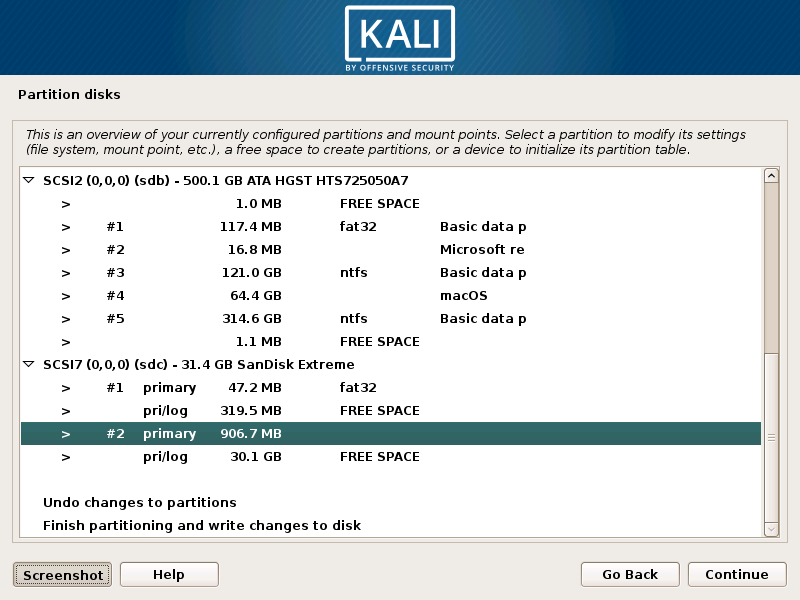

- CREATE A KALI LINUX BOOTABLE USB FOR MAC HOW TO
- CREATE A KALI LINUX BOOTABLE USB FOR MAC INSTALL
CREATE A KALI LINUX BOOTABLE USB FOR MAC INSTALL
Next screen will ask you if you want to install GRUB, say YES and install it.
CREATE A KALI LINUX BOOTABLE USB FOR MAC HOW TO
If you already created an MS-DOS partition on Step 1 you already have a place for this installation so all you need to do is to tell the installer how to format it. When you arrive to the partitions screen pay very close attention to where you are installing Kali, if you choose the MacOS partition you will be kicking yourself in the head.Click through the screens where you setup your date/time/language settings.Once you’re on the Kali Boot Menu, select Graphical Install (or regular Install if that’s what you prefer).
 On the EFI boot screen Live Kali USB is recognized as “Legacy OS”, choose it and hit. Undo what you did in step 5 by typing csrutil enable. Now restart and hold down Option again, boot into Recovery mode one more time. Run the refind-bin-xxx binary in the Terminal. Launch Terminal, locate previously downloaded refine-bin-xxx.zip file and unzip it. Once in the Recovery mode, go to Utilities > Terminal. Whether you have the recovery partition or a bootable USB, restart your Mac and hold down the Option button. If you don’t already have a Recovery partition on your Mac, create a bootable USB drive(see link above) and install the latest version of MacOS (at the time of writing it is Sierra 10.12.5), you will need this to temporarily turn off System Integrity Protection (SIP) so you can install rEFInd bootloader. Create a partition on your hard drive that is big enough to put Kali on using your MacOS Disk Utility tool. Things you will need: (2 Usb sticks OR other bootable media such as DVD/CD Roms). Mostly I wrote these steps down for myself so I can replicate it in the future.
On the EFI boot screen Live Kali USB is recognized as “Legacy OS”, choose it and hit. Undo what you did in step 5 by typing csrutil enable. Now restart and hold down Option again, boot into Recovery mode one more time. Run the refind-bin-xxx binary in the Terminal. Launch Terminal, locate previously downloaded refine-bin-xxx.zip file and unzip it. Once in the Recovery mode, go to Utilities > Terminal. Whether you have the recovery partition or a bootable USB, restart your Mac and hold down the Option button. If you don’t already have a Recovery partition on your Mac, create a bootable USB drive(see link above) and install the latest version of MacOS (at the time of writing it is Sierra 10.12.5), you will need this to temporarily turn off System Integrity Protection (SIP) so you can install rEFInd bootloader. Create a partition on your hard drive that is big enough to put Kali on using your MacOS Disk Utility tool. Things you will need: (2 Usb sticks OR other bootable media such as DVD/CD Roms). Mostly I wrote these steps down for myself so I can replicate it in the future. 
This is not an overly comprehensive guide, it is very high level and assumes you know your way around linux/macOS. Also if you pick the wrong partition while writing the Kali files to disk you will hose your macOS installation as well, so there, you've been warned! A second laptop or a tablet with internet connection is extremely helpful for looking up things in case you run into issues. This was my journey, YMMV, proceed with caution. Tested this on a mid-2012 MacBook Pro (Model: A1286).
Because you’re old school and have nothing better to do on a long weekend?. You will have full access to the Hardware, which is especially important when you’re dealing with Wi-Fi radios etc. Run apt-get update, apt-get upgrade to your heart's content. You can customize it as much as you’d like. It’s 2017, why dual boot Kali instead of using a VM/docker image/Bootable USB with persistence?







 0 kommentar(er)
0 kommentar(er)
